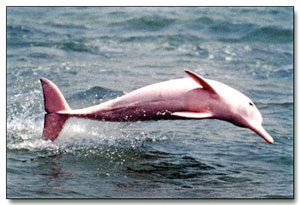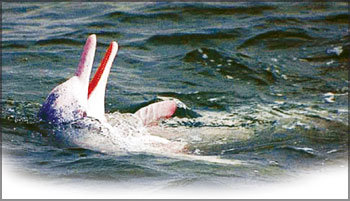|

Those of you who remember the popular television series Flipper
featuring a dolphin, (a sea mammal), would recall how intelligent the
endearing dolphin in that series was. Everyone loved Flipper with the
'smiling face'. No one liked to see it come to any harm, even though
people knew the danger was all ficticious, as it was only a movie.
That's because dolphins have a closer relationship with humans than most
other sea creatures. They are considered to be very intelligent, and
there are many records of those 'cute' looking sea mammals helping
humans in distress at sea.
  Have
you seen dolphins? If you visit the Dehiwela Zoological Gardens, you can
see these cute mammals. However, the dolphins at the Dehiwela zoo are
sea dolphins - not freshwater dolphins like the pink dolphins we feature
today. Now, you are bound to be amazed to hear that there are actually
pink dolphins alive! They are not mythical creatures like the white
unicorns. You can really see cute pink dolphins, if you ever visit South
America or the Sentosa Island in Singapore. The pink dolphins are mostly
found in the tributaries and the main river of the an Amazon and Orinoco
River System of South America. They are one of the five species of
freshwater dolphins in the world. The other four species are the baiji
or Chinese river dolphin - a white coloured mammal which is severely
endangered with only about 300 individuals believed to be left in the
Yangtze River, (the only place they are found), the Franciscana dolphin
(which is rather uncommon) and is a relative of the Chinese river
dolphin which inhabits the shallow areas of the ocean along the coast of
South America, the Ganges river dolphin, found in the rivers of India
and Bangladesh, and the Indus river dolphin, which is virtually
sightless and is found in the Indus river system of Pakistan. It is also
an endangered species. Have
you seen dolphins? If you visit the Dehiwela Zoological Gardens, you can
see these cute mammals. However, the dolphins at the Dehiwela zoo are
sea dolphins - not freshwater dolphins like the pink dolphins we feature
today. Now, you are bound to be amazed to hear that there are actually
pink dolphins alive! They are not mythical creatures like the white
unicorns. You can really see cute pink dolphins, if you ever visit South
America or the Sentosa Island in Singapore. The pink dolphins are mostly
found in the tributaries and the main river of the an Amazon and Orinoco
River System of South America. They are one of the five species of
freshwater dolphins in the world. The other four species are the baiji
or Chinese river dolphin - a white coloured mammal which is severely
endangered with only about 300 individuals believed to be left in the
Yangtze River, (the only place they are found), the Franciscana dolphin
(which is rather uncommon) and is a relative of the Chinese river
dolphin which inhabits the shallow areas of the ocean along the coast of
South America, the Ganges river dolphin, found in the rivers of India
and Bangladesh, and the Indus river dolphin, which is virtually
sightless and is found in the Indus river system of Pakistan. It is also
an endangered species.
Out of all these freshwater dolphins, the Inia geoffrensis or the
pink dolphin, the largest of the river dolphins, has become a major
attraction, obviously due to its unusual skin colour. However, no one
has been able to explain as to why these creatures are coloured this
way. Some researchers say the dolphin's pink flush maybe due to
capillaries (small blood vessels) near the surface of the skin. (The
dolphins have been known to turn a dark pink colour when they are
excited.) Many others attribute the unusual colour of these mammals to
the chemical disposition of the water they live in (as it contains a lot
of iron), and other factors such as the temperature and the age of these
animals.
  The
pink dolphins, also known as botos in Brazil and bufeo colorado in Peru
are very similar in appearance to sea dolphins, at a glance, but there
are certain marked differences between the two species. For instance,
the pink dolphin has a hump on the back instead of a dorsal fin and also
an unfused vertebrae (backbone) in the neck which makes it unique. This
unfused vertebrae allows the freshwater dolphin more flexibility
(ability to bend) in flood plain forests, grasslands, tributaries and
shallow water. It can turn its head 180 degrees when moving about in the
water, winding its way in between trees and plants in the flood plain.
It also has a long powerful beak (often lined with tiny hairs), small
eyes, a larger tail than the grey dolphins, disproportionately large
flippers (which look like big leaves) and a highly flexible body. Though
these were once considered to be rather primitive features, they are now
recognised as special adaptations to a highly complex environment that
the animals live in. The
pink dolphins, also known as botos in Brazil and bufeo colorado in Peru
are very similar in appearance to sea dolphins, at a glance, but there
are certain marked differences between the two species. For instance,
the pink dolphin has a hump on the back instead of a dorsal fin and also
an unfused vertebrae (backbone) in the neck which makes it unique. This
unfused vertebrae allows the freshwater dolphin more flexibility
(ability to bend) in flood plain forests, grasslands, tributaries and
shallow water. It can turn its head 180 degrees when moving about in the
water, winding its way in between trees and plants in the flood plain.
It also has a long powerful beak (often lined with tiny hairs), small
eyes, a larger tail than the grey dolphins, disproportionately large
flippers (which look like big leaves) and a highly flexible body. Though
these were once considered to be rather primitive features, they are now
recognised as special adaptations to a highly complex environment that
the animals live in.
Unlike the sea dolphins, the pink dolphins, including all the other
freshwater dolphins, don't usually live in large pods. This is because
they have no natural predators other than humans. So, they don't need to
gang up for protection. Pink dolphins are found in small family pods of
five to eight individuals. The family pods are led by a dominant adult
male. However, they adapt solitary feeding and hunting strategy during
the high water season when their prey disperses into the floodstream.
The diet consists of crustaceans, catfish and other small fish.
|

Out of all the freshwater
dolphins, the pink dolphin is the largest. |
These pink dolphins grow to about 2.5 or 3 metres (8.25 ft. to 9.15
ft) in length and weigh around 90 kg (200 lbs). Males are generally
larger than the females. The calves, born between July and September,
after a gestation period of 9-12 months, are 75 cm (30 in) long and
weigh over 1 kg ( 2.2 lbs).
Male dolphins reach maturity when they are about 2 metres (7 ft) long
and females by the time they are 1.7 m (5.5 ft) long. Some say the
calves are born grey and turn pink with age.Like the ocean or sea
dolphins, pink dolphins too are reported to help humans in distress:
They have been seen pushing people ashore after their canoes have
capsized.
Dolphins are special and need to be protected, especially because of
the close relationship they've had with man from ancient times. They are
known to help us when we are in distress, so why not help them when they
too are in distress? Presently they are a threatened species that needs
to be protected. We must do whatever we can to save these cute pink
mammals and their cousins too from extinction.
Facts and pix: Internet
*********
Fact file
* The ancestors of the Inia species are believed to be a relatively
successful marine group. Scientists believe that this species may have
entered the Amazon from the Pacific Ocean approximately 15 million years
age or from the Atlantic Ocean between 1.8 million and 5 million years
ago.
* Dolphins are known to be one of the most intelligent, friendly and
sensitive mammals, with a brain capacity about 40 per cent larger than
that of humans.
* Even though they've lived in harmony with humans for a long, long
time, today they are faced with extinction in some parts. About 20 years
ago they were considered to be the least threatened, but now pink
dolphins are most endangered (like the other freshwater dolphins) due to
accelerated and commercialised development programmes in the region.
They are an important link in the ecosystem that needs to be protected.
* Pink dolphins figure prominently in myths.
* In some tributaries, pink dolphins are known as unpredictable
brujos (wizards). They are also considered to be benign and semi-divine
beings.
* Grey dolphins are sacred among Indian tribes.
* Pink dolphins are unique among dolphins because of their molar-like
teeth which can chew prey. They have 20-30 peg-like teeth.
* They can swim at speeds up to 20 miles per hour. An interesting
fact is their ability to rest on the bottom of the river. They can sleep
submerged up to 15 minutes in water. Males sleep just beneath the
surface and come up to breathe.
* The pink river dolphin species was first described by Henri Marie
Ducrotay Blainville in 1817.
* Pink dolphin mamas normally take care of their calves for 1-3
years. They get assistance from the other members of the 'pod' to look
after the young.
* Some of the other names by which the pink dolphins are known - Boto
vermilho, tonina, pink porpoise and Amazon dolphin.
* Of the freshwater or river dolphins, the Franciscana is the
smallest. It is found in Brazil and Argentina. This river dolphin, also
called the La Plata Dolphin lives in salt-water estuaries.
* There are sub species of freshwater dolphins.
* The Inia species of dolphins come in different colours: Rosy
coloured pink, bright pink, dull-grey pink, gray and albino, depending
on their age and geographical area where they live. In the Amazon River
they are usually pinkier while in the Orinoco River they are more grey.
In the Arauca River in Colombia (a tributary of the Orinoco River)
dolphins are very pink.
********* |


